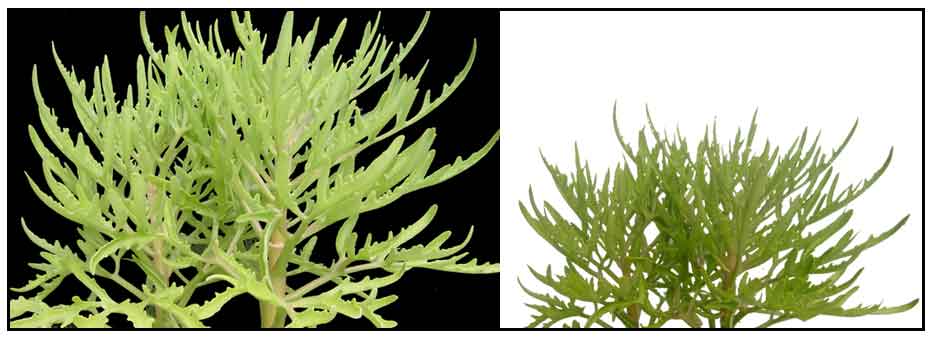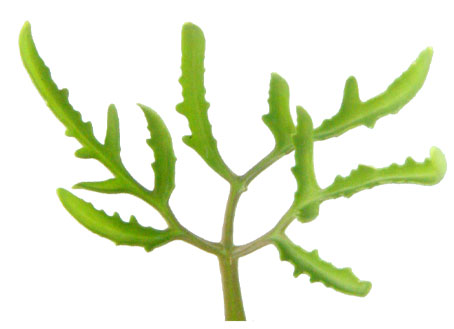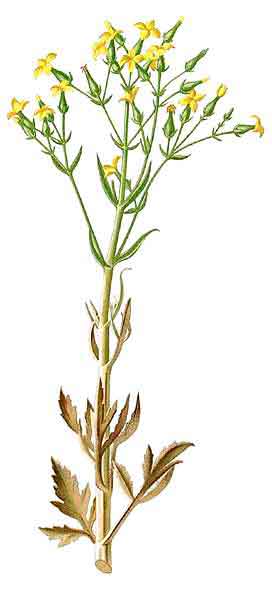|  Botany Botany
Siempreviva is an erect, simple, smooth and robust perennial herb,
less than a meter high. Leaves are opposite, fleshy, pinnatisect, 8
to 15 centimeters long, with the lobes distant, spreading, subentire, toothed
or somewhat lobed and lanceolate, an d few. Inflorescence is terminal and peduncled.
Flowers are about 1.5 centimeters long. Sepals are green and lanceolate. Limb
of the corolla is spreading, and about 2 centimeters in diameter. d few. Inflorescence is terminal and peduncled.
Flowers are about 1.5 centimeters long. Sepals are green and lanceolate. Limb
of the corolla is spreading, and about 2 centimeters in diameter.
Distribution
- Introduced into the Philippines.
-
Occasionally cultivated in gardens.
- Also occurs in India to tropical Africa, and China and Java.
Constituents
- Leaves reported to contain
chlorophyll, fat, a yellow organic acid, cream of tartar, sulphate of
calcium, free tartaric acid and calcium oxalate.
- Leaves also reported to contain malic acid.
- Reported to contain cardiac glycosides.
- Leaf extracts reported to yield flavonoids, triterpenoids, lignins, phenols, saponins, and glycosides. (5)
- Study has reported three toxic bufadienolides, one characterized as hellibrigenin 3-acetate. (Anderson et al., 1983) (5)
- A variety of cardiotoxic bufadienolides are present in all parts, more so in the flowers. The cardiotoxins include bryotoxins, bryophyllins, bersalgenins, flavonoids, and glycosides. (6)
- Phytochemical analysis showed the n-hexane extract to yield tannins and terpenoids, while the aqueous methanolic extract yielded saponins, tannins, terpenoids, flavonoids, glycosides and anthraquinones. (11)
Properties
- Leaves considered styptic, astringent and antiseptic.
- Studies suggest anti-inflammatory, antidiabetic, antitumor, and anti-leishmanial activities.
 Parts used Parts used
Leaves.
Uses
Folkloric
• In the Philippines pulped leaves are
applied to chronic ulcers and sores; also used for headaches.
• In Malaysia poultice of powdered leaves used for colds and coughs, to soothe inflammation, heal boils and wounds; used as lotion in small pox. Decoction of whole plant drunk for gastric pain and heart discomfort. (5)
• In Cambodia, Laos and Vietnam, crushed leaves applied externally for fever and to heal ulcers. (5)
• In India crushed leaves applied to wounds, to soothe inflammation and to cure diabetes. Juice from leaves drunk to treat bilious diarrhea, dysentery, lithiasis and phthisis. (5)
• In Indo-China pounded leaves applied to indolent ulcers. (5)
• In Ambonia, leaves used for poulticing
fevered heads and bodies.
• In traditional Indian medicine, fresh leaves are bruised or
roasted over fire and applied as poultice to bruises and contusions
to relieve inflammation and prevent discolorations.
• Used as a styptic to fresh cuts, abrasions and wounds. Also
used for venomous insect bites.
• Juice mixed with butter, 1:2, taken internally for diarrhea, dysentery, lithiasis,
cholera and phthisis.
• In Indo-China, leaves are used
as topicals for ulcers.
• In the Antilles, used for headaches
and as an emollient.
• In India plant is used for treating common cough and cold, wounds, inflammation, diabetes, etc.
• In southern India leaf extract applied externally for joint pain.
• In Ayurveda leaves use for menorrhagia, hemorrhoids, ulcers, renal stones, abscesses, cuts and wounds, ulcers, diarrhea, vomiting, and inflammation; used to pacify vitiated vata, pitta. (8)
• Ethiopians use fresh root extract intranasally for treatment of tonsillitis.
• In Brazil, used for treatment of ulcers and gastritis; also used as anti-inflammatory and analgesic. (14)
Others
• Superstition: Malays place twigs in houses to attract good spirits.
• Ethnoveterinary: In West Ethiopia, fresh or dried roots of K. laciniata, seeds of Capsicum frutescens and Allium sativum, and leaves of Croton macrostachys are powdered together and applied to blackleg affliction in cattle. (15)
Studies
• Cytotoxicity
/ Anticancer: Study
of effects of several plants on in vitro proliferation of hormone dependent
breast cancer and colon cancer lines showed the hexane extract of Kalanchoe
laciniata was effected against cellular proliferations of MCF-7 (hormone
dependent breast cancer cell lines.
(1)
• Secondary Metabolites: Phytochemical screening for secondary metabolites yielded emodins, flavonoids, lignins, triterpenoids, anthraquinones, phenols, saponins, leucoanthocyanins, and glycosides. (7)
• Antiproliferative: Study showed a hexane extract of Kalancho laciniata was effective against cellular proliferations of MCF-7the effects of K. laciniata. (10)
• Antibacterial / Antioxidant / Gut Modulating: Study evaluated the antibacterial, antioxidant, and gut modulating activities of a 70% crude methanolic extract of K. laciniata. In antibacterial assay, the extract showed effective activity against Staphylococcus aureus and Bacillus subtilis with MIC of 5 and 2.5 mg/mL, respectively. Antioxidant evaluation showed 17.3 ± 3.0% DPPH free radical scavenging, with total phenolic contents of 27.3 ± 1.8 mg GAE/g DW and22.7 ± 2.1 AAE/g DW total antioxidant activity. Gut modulatory activity by in vitro testing on rabbit jejunum showed maximal spasmogenic response of 28.4 ± 4.6% at 3 mg/mL, with EC50 spasmolytic response of 3.2 mg/mL. (13)
• Genotoxic and Mutagenic Potential / Safety Concerns: Study evaluated the genotoxic and mutagenic effect of Kalancho laciniata. Study concludes whole plant extracts of K. laciniata were significantly mutagenic and cytotoxic. Both genotoxicity and cytotxicity increased with concentration of aqua-methanolic and n-hexane extracts. Based on in vitro investigation, K. laciniata is not considered safe for use in humans. Study suggests further studies on animal models to assess for pathological lesions and alterations in biochemical parameters. (16)
• Antiproliferative / Anti-Breast Cancer (MCF-7) Cell Line: Study evaluated the effect of Catharanthus roseus, Kalanchoe laciniata and Piper longum on the in vitro proliferation of hormone dependent breast cancer (MCF-7) and colon cancer (Caco2) cell lines. Only the hexane extract of K. laciniata was effective against cellular proliferation of MCF-7. (17)
• Anti-Venom Activity / Leaves: Study characterized chemical constituents and the inhibitory effects of hydroethanolic extract of leaves of K. brasiliensis and K. pinnata against local effects induced by Bothrops jararaca snake venom. Both extracts significantly reduced the hemorrhagic activity of the venom in pre-treatment protocol, while only K pinnata was active in post-treatment protocol. Both extracts inhibited phospholipase activity; however, K. pinnata was more active. Results showed potential antiophidic activity of Kalanchoe species against local effects induced by B. jararaca snake venom and suggest potential new source of bioactive molecules against bothropic venom. (18)
Availability
Wildcrafted. |


 Botany
Botany d few. Inflorescence is terminal and peduncled.
Flowers are about 1.5 centimeters long. Sepals are green and lanceolate. Limb
of the corolla is spreading, and about 2 centimeters in diameter.
d few. Inflorescence is terminal and peduncled.
Flowers are about 1.5 centimeters long. Sepals are green and lanceolate. Limb
of the corolla is spreading, and about 2 centimeters in diameter. Parts used
Parts used

